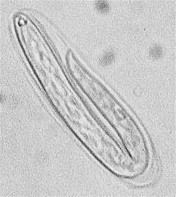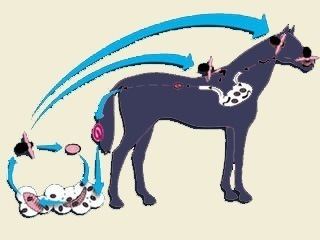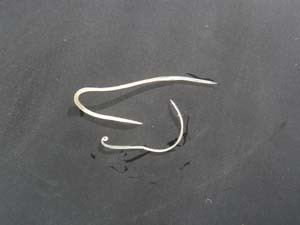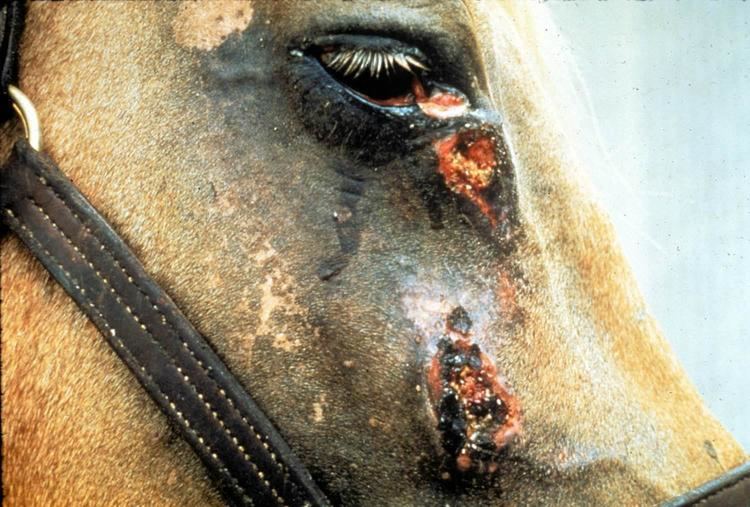Species Habronema muscae Higher classification Habronematidae | Family Habronematidae Scientific name Habronema Rank Genus | |
 | ||
Similar Strongylus, Parascaris equorum, Gasterophilus, Strongylus vulgaris, Triodontophorus | ||
Habronema larvae why summer sores don t heal
Habronema muscae is an internal stomach parasite that is most commonly found in horses.
Contents
- Habronema larvae why summer sores don t heal
- Habronema sp
- Eggs
- Larvae
- Adults
- Skin
- Eyes
- Respiratory system
- Digestive system
- Interventation
- Indications
- Counter indictations
- Control
- Ivermectin
- Moxidectin
- External fly repellents
- References
Habronema sp
Eggs

The parasitic adult female worms lay eggs within the horse's stomach. The eggs are later excreted through the feces. The eggs hatch out within the faeces producing first stage larvae.
Larvae

After the eggs have hatched in the faeces, the larvae are ingested by the maggots of variousflies that lay their eggs in the faeces (such as Stromoxys (The Stable Fly) or Musca (The House Fly). The nematode larvae develop within the maggot for about one week (depending upon ambient temperature), as the maggots mature into the imago (adult) fly. The infective larvae migrate to the mouthparts of the fly, where they are passed on to the horse when they feed around the horse’s moist areas such as wounds, nostrils, lips, and eyes. If the larvae are deposited into open wounds, or broken skin they can cause intense granulomatous reactions, producing an ulcerated irritation called “summer sores”. They may also invade the eye and the eye membrane causing a persistent conjunctivitis. If the larvae find their way up through the nose they can migrate into the lungs and cause tiny abscesses around where they embed in the lung tissue.
Adults

When the larvae are licked and swallowed by the horse during grooming they travel to the stomach and embed themselves into the glandular part of the stomach close to the margo plicatus. A thick mucus is excreted by the stomach lining. The larvae mature into adults and females produce eggs to complete the life cycle. Larvae that invade skin or eye tissue do not develop into adults.

Morphology: Adult has two lateral lips, dorsal and ventral lips may also be present. Buccal capsule cylindrical, chitinous. Oesophagous is divided into two parts, a short anterior muscular and long posterior glandular portion, intestine simple without any diverticula. Male: spicules unequal, gubernaculum present and bears 4 pairs of preanal, 1 pair adanal and 2 pairs of postanal pedunculated papillae, 3 pairs of sessile papillae also present, tail spirally twisted.
Skin

If the larvae which are in the mouthparts of the immediate host are deposited in the open skin well the fly feeds it can cause summer sores. Summer sores are ulcerated irritations. These lesions can cause soreness and itchiness and become covered in a reddish-yellow tissue.
Eyes
If the worms get deposited into the eye or the area around the eye it can cause a persistent case of conjunctivitis.
Respiratory system
If the larvae travel through the nose, into the pulmonary system and then the lungs, they can cause abscesses in the lung tissue where they imbed themselves in the lungs tissue.
Digestive system
When the adult worms imbed themselves into the mucus lining of the stomach in large numbers digestion can be affected. With even larger numbers the passing of food can be completely blocked.
Interventation
The stages of Habronema that you can intervene are the eggs, and larvae in the horse. The eggs can be disposed by proper sanitation, and manure disposal. The eggs can be properly disposed of by manure control, because the eggs are passed out of the horse in feces. The other stage is when the larvae are swallowed by the horse. You can stop the cycle by properly de-worming. Those are the two stages in which you can intervene the life cycle of Habronema.
Indications
A common de-wormer that is effective against Habronema is ivermectin. Common brand names for ivermectin include: Zimecterin, Rotation 1, and Eqvalan. The indications for ivermectin are the disposal of the parasites: Large strongyles, small strongyles, stomach worm (Habronema, and Trichostrongylus), adult pinworms, adult safaris, neck threadworms, and bots. Ivermectin works by disrupting the flow of a chemical called GABA. GABA is a neuromuscular chemical that is found naturally throughout the body. The disruption of the GABA in a parasite causes paralysis in the parasites, and death soon follows. In mammals GABA is only found in the central nervous system, (brain and spinal cord) and is protected from the ivermectin.
Counter indictations
Ivermectin is not effective against tapeworms and flukes since they don’t have the chemical GABA. Other horses that have the infectious disease called "sickness" should not be given ivermectin. Sleeping Sickness which temporarily breaks down the protective layer of the central nervous system causes the ivermectin to affect GABA. Therefore, horses with sleeping sickness should not take ivermectin.
Control
There are two ways to control Habronema. The first way was stated earlier, by proper disposal of manure, since the eggs are excreted through the feces. The other way was control of fly population. The larvae are picked up by flies when they feed in the feces. The flies act as in intermediate host for the parasites, until they can find a permanent host. Proper control of the fly population (house flies, horse fly, and face fly can all carry Habronema) can decrease the possibility of your horse being infected by habronema. Those are the two most efficient ways to control the parasite habronema.
Ivermectin
Ivermectin, with brand names such as Eqvalan, Zimecterin, and Rotation 1, is an antibiotic that is a fermentation product of the microorganism Streptomyces avermitilis. Ivermectin disrupts the flow of the neuro-muscular chemical GABA. In parasites GABA is found throughout the body, but in mammals it is protected by the central nervous system and the spinal column. In parasites the ivermectin affects the flow of GABA and causes paralysis and brings death quickly to the parasite. In sleeping sickness disease the horse’s protective layer around the spinal cord is temporarily broken down. Horses with sleeping sickness shouldn’t take ivermectin. Ivermectin doesn’t work against parasites that don’t have GABA such as tapeworms, and flukes.
Moxidectin
Moxidectin was introduced in 1997; its brand name is Quest. Moxidectin interferes with the chloride channel neurotransmission in the parasite. This results in paralysis and death. The Moxidectin works just like the Ivermectin but disrupts a different neurological chemical. Moxidectin was the first anthelmintic that was approved for encysted cyathostomes.
External fly repellents
External Fly repellents are effective against Habronema too. The use of fly repellents will not kill the flies but will only repel them. Therefore, the fly repellent will not kill Habronema but only reduce the possibility of your horse getting "summer sores", or other problems. This is because habronema is carried to the horse by flies.
